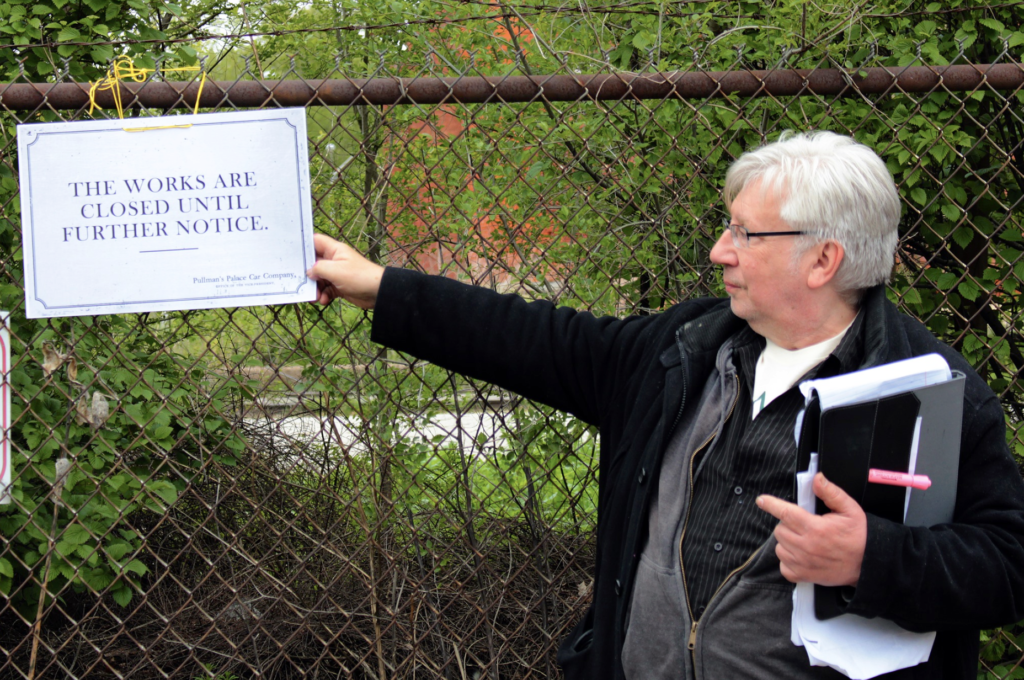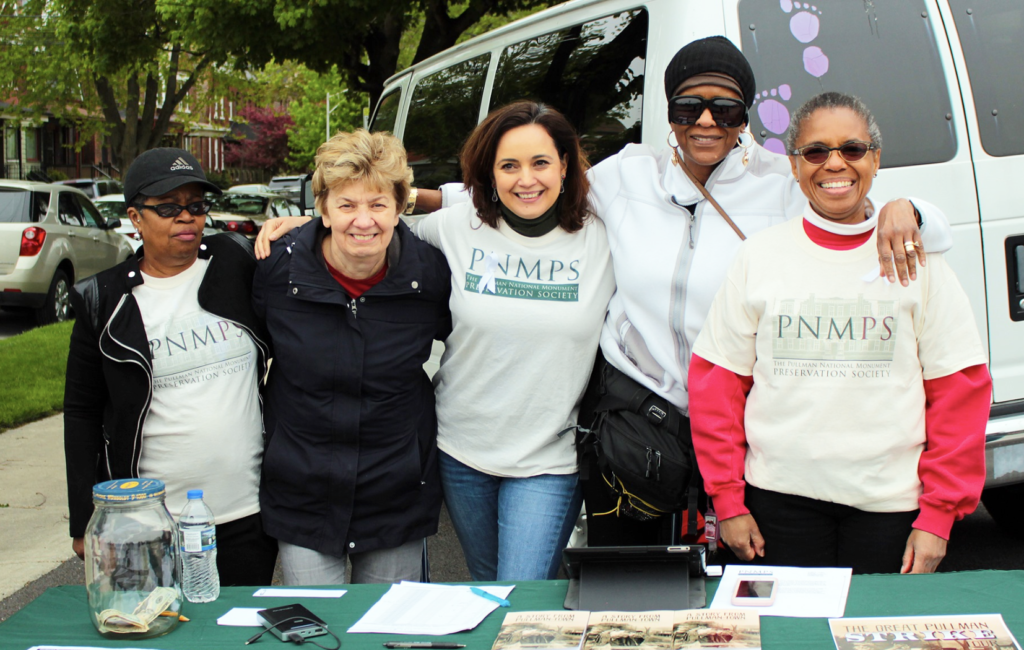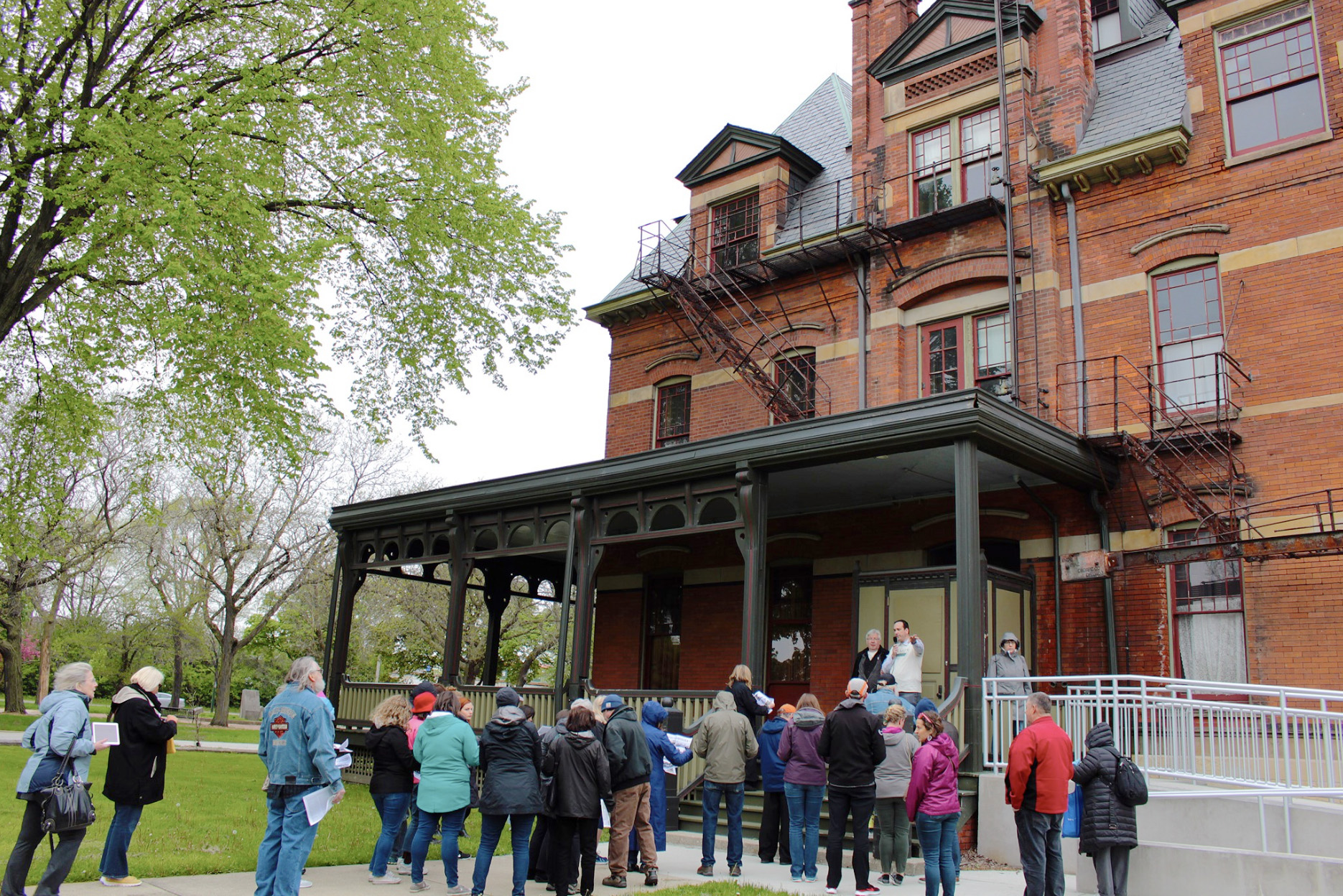On an overcast Saturday afternoon, more than thirty people gathered at the old Pullman Livery Stables on 112th and Cottage Grove and pinned small white ribbons to their raincoats. One hundred and twenty-five years ago, Pullman residents—and people across the country—wore similar ribbons to show their support for the workers of the Pullman Palace Car Company, who laid down their tools and walked off the job on May 11, 1894.
To commemorate the anniversary of the Great Pullman Strike of 1894, the Pullman National Monument Preservation Society (PNMPS) hosted their first strike-focused tour of the neighborhood. The tour aimed at providing a “short, broad-stroked history of the strike” from the perspective of the workers who lived and organized in Pullman, according to PNMPS member and lifelong Pullman resident Paul Petraitis, who led the tour alongside PNMPS President Mark Cassello. Those gathered for the tour included Pullman residents, teachers, students, and history buffs from across the South Side.
The PNMPS is a group of self-described “watchdogs” that formed in 2015 to ensure that the National Parks Service’s stewardship of the Pullman National Monument—established by President Barack Obama the same year—lived up to its goal of preserving and authentically restoring what was once the Town of Pullman.
From 1880 to 1907, this 4,000-acre “model town” was controlled by the Pullman Palace Car Company, which for most of its existence was synonymous with its president, George Pullman. At the turn of the twentieth century, Pullman’s luxury railcars led to his becoming the largest manufacturing company in the world. Most of the company’s workers lived in the town, paying rent and utilities to the company. There were no elections for town leaders, and even the schools were run by the company. This was Pullman’s paternalism: he provided his workers with good housing in an idyllic town, hoping that a happy laborer would also be a more productive one.
In the wake of the panic of 1893, a recession that reduced demand for the luxury railcars the company manufactured, Pullman drastically cut his workers’ wages without reducing rent. Workers could no longer afford to feed their families. After failed attempts to negotiate with the company for higher wages or lower rents, and after several workers were fired for expressing their grievances despite being assured there would be no retaliation, Pullman workers walked out. In the coming weeks they were joined by a quarter-million railway workers across the country. Workers overturned and burned boxcars and caused millions of dollars in property damage. The federal government obtained an injunction calling for an end to the strike, citing obstruction of mail and interstate commerce, and President Grover Cleveland deployed the National Guard to Pullman to enforce it.
Cassello and Petraitis led our group from the stables to our first stop: the once-bustling Hotel Florence, a stately brick building with green and red detailing. It was too expensive for the average worker to drink there, Petraitis said, and besides, Pullman didn’t want his workers getting drunk—in fact, he deliberately kept taverns and liquor stores out of Pullman Town. As we approached the hotel’s porch, we saw a woman gardening in a small plot on the hotel’s lawn, the same place where the National Guard had camped during their deployment. We took turns peering through a window into the building’s dusty, empty lobby—the hotel is now owned by the state and is undergoing a lengthy and pricy restoration—then filed down the steps and back onto the street.
“We lost a bit of historic sidewalk here just last month,” Petraitis noted sadly as we left the hotel, explaining that the city had installed some new sidewalk that “we didn’t ask for.”
“You gotta be ever-vigilant,” he warned.
We crossed the street to the main gate of the factory, which will become the home of the Pullman National Monument visitor information center next year. We were invited to stand and imagine what it would have been like to see workers streaming through the factory gates, the crowds growing larger as word of the strike spread. Through the chain-link fence that now surrounded the building, visitors could see the old factory building, as well as the yards where completed train cars were once lined up for viewing like a car showroom.

Gripping pages of notes and lugging a speaker behind him, Petraitis apologized to the cars we held up as we crossed the street—“Excuse us please, we’re remembering history here. This is public education”—and made our way across quiet, leafy Pullman, heading toward the famous rowhouses that Pullman built for his workers.
Rain began to fall as we stopped at our first house, 11302 South Champlain, once home to an unfortunate man named Buckley Wood. Wood was a factory watchman who made the mistake of asking a worker for his company pass. (Workers were required to present passes in order to remove their tools from the shops at the end of the workday.) The worker attacked Wood with a hatchet, leaving him debilitated. When he died the following year, his family could not pay rent. The Pullman Company attempted to evict them, though the family and the company eventually negotiated an agreement that allowed them to stay.
Just a few houses down, at 11310 South Champlain, was the home of Jennie Curtiss, a seamstress and union leader. Cassello played an audio recording of an actor reading Curtiss’ testimony to the Strike Commission, in which she described the pay cuts and “tyrannical and abusive forewomen” in the sewing shops, where women toiled away creating mattresses, sheets, pillowcases, and other linens for the palace cars’ sleepers and dining rooms. After failing to negotiate higher pay or lower rent for her fellow workers, she joined the American Railway Union (ARU) and became president of the Girls Union, Pullman Local 269.
The seamstress’s words filled the air as we faced the brick building where she had lived: “We struck at Mr. Pullman because we were without hope. We joined the ARU because it gave us a glimmer of hope.”
Later, we gathered in a circular courtyard at the former site of the Market Hall, which burned down in 1973. We were standing at the site of a historic melee. Women who worked in the Pullman laundries, many the wives of striking workers, were on strike, too. When women in nearby Roseland tried to sneak into Pullman and replace them, the Pullman ladies had none of it.
“So the girls in Roseland tried to sneak into the laundry over there as scabs and some of the starving wives in Pullman caught ’em here,” Petraitis explained. The Pullman women were, to put it mildly, not pleased; one of them instructed others to get out their knives and “spoil her beauty!”, as recounted in a hyperbolic Tribune article from the time. The Roseland women had to be escorted by police back along 111th Street, “dodging missiles all the way”—rocks and pieces of brick thrown by the striking women.
And a tour of Pullman wouldn’t be complete without a visit to “Poverty Row.”
“George Pullman had enjoyed thirteen years of really great publicity in this model town, and then he had the benefit of the Columbian Exposition to promote it even more,” Cassello said. “But when the strike broke out, people had to make an argument that conditions in Pullman weren’t as nice as they’d been led to believe in the press accounts.”
So journalists were taken to visit a different Pullman: the tenement housing on Langley Avenue, just one block from the charming rowhouses on Champlain. “These people over here were living five families to one faucet,” Cassello explained. Journalists saw squalid housing and starving infants. Today, though, we saw several squat buildings under construction, the future home of the Pullman Artspace Lofts, a thirty-eight-unit development that will also include classrooms and a gallery for local artists. (PNMPS is opposed to this development, with their website repeatedly claiming that “historic reviews of the Pullman Artspace Lofts were improperly conducted and potentially unlawful.” The U.S. Department of Housing and Urban Development recently ordered another review to ensure historic preservation guidelines were followed. With the review complete, the project is underway again.)
The strike ended with the National Guard’s deployment. Violence broke out across the nation, and the National Guard was accused of firing indiscriminately into crowds; thirty people were killed, half of them in Chicago. Striking workers were allowed to return to work, but the Pullman Company forced them to sign “yellow-dog contracts” vowing they wouldn’t be part of a union. After Pullman died in 1897, his grave was reinforced with concrete and steel rails to protect against desecration by angry workers. The following year, the Illinois Supreme Court ruled the company had to divest its ownership in the town, and Pullman became part of the City of Chicago.

PNMPS wasn’t the only group in Pullman on May 11 to commemorate the strike. Two members of the Illinois Labor History Society led their own, smaller tour, which our group ran into at a couple points throughout the afternoon. That morning, at the National Monument’s visitor information center, representatives from various history and preservation organizations had a panel discussion about the strike, its legacy, and its relevance today.
In her remarks, Sue Bennett of the National Parks Service called George Pullman a Mark Zuckerberg of his time, drawing a parallel between Pullman’s railroad empire and the vast power of companies like Facebook. “[Zuckerberg’s] business partner has said that he has power that is unprecedented and un-American. Boy, have I heard people say that about George Pullman as well.”
Guest speaker Allison Duerk, executive director of the Eugene Debs Foundation in Terre Haute, Indiana, grew emotional as she described how the Pullman Strike grew from “a dispute between 2,000 workers and one employer to a national standoff between 250,000 members and the combined interests of the railroads.”
Guest speaker Sara Nelson, international president of the Association of Flight Attendants-CWA, spoke about the relevance of the Pullman strike to the recent labor struggles of airline workers. As with the ARU, airline strikes are complicated by the complex global nature of the economy. “Our jobs are connected. We can’t live without each other,” she explained.
The PNMPS tour concluded at the Pullman Café, not so much for its historical import as its cozy atmosphere. Over slices of almond cake, which had been decorated in red icing with “Strike: 1894-2019,” I asked attendees what they thought of the tour.
Two history teachers at Homewood-Flossmoor High School told me that they typically devote a whole lesson in their history curricula to the Pullman Strike due to the school’s location in the south suburbs, and that they were grateful for the chance to bring more detail and context to their lessons. Hazal Corak, an anthropology PhD student at the University of Chicago, said that she was most surprised to see signs for the future Artspace Lofts on what was was once called Poverty Row.
“The fact that we’re not even really in the city and still somebody, an entrepreneur, has a vision about what this area can become, like artists’ lofts and such—it was very striking,” Corak said, pun not intended.
Preservation was on everyone’s minds, from the tourists to the PNMPS members leading their crusade to save Pullman right down to its sidewalks. But preserving the memory of an event in history, and making sure it’s still taught for generations to come, is a little different from preserving a physical place. The speakers, historians, and tour organizers hoped to commemorate an event that affected so many people: not only those who lived and toiled and suffered and lost their lives here on the South Side of Chicago, but those across the country who struck in what Duerk described as “an unprecedented act of solidarity,” a show of what can be accomplished when workers rise up, and the forces they face when they risk it all.
Or as Nelson, the flight attendant union president, summed it up in her speech that morning: “We’re not taught labor history in this country, and there’s a reason for that. It’s too powerful.”
Helena Duncan is a writer based in Hyde Park. She last wrote for the Weekly in March about designs for a public memorial to survivors of police torture.


Student Hazal Corak has a few things really wrong here. 1. The Pullman National Monument/Historic District IS in the city of Chicago. 2. The Pullman Artspace Lofts project was conceived through a grass roots effort of Pullman neighbors (not an entrepreneur’s “vision”) later becoming the 501c3 “PullmanArts” who later joined with the non-profit orgs Artspace,Inc (www.artspace.org) and Chicago Neighborhood Initiatives to develop the project. For project facts, please visit http://www.artspace.org/pullman